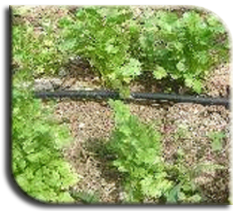Coriander (Coriandrum sativum L.)
Apiaceae |
 |
Coriander Leaf and Seeds |
|
|
| Varieties |
 |
|
| Co.1 |
- Superior variety of germplasm selection (TNAU)
- Dual purpose, 110 days, Tolerant to grain mould
- Seed yield of 800 kg/ha (rainfed conditions) and 2000 kg/ha (irrigated conditions)
|
| Co.2 |
- Reselection from the type P2 of Gujarat
- High yielding dual purpose variety, tolerant to drought
- 90-100 days, yield (600-700 kg/ha)
|
| Co.3 |
- Pure line selection from Acc. No. 695, IARI
- Dual purpose, less susceptible to wilt and grain mould
- Duration is 90 days, yields (650-700 kg/ha)
|
| CS 287 |
- Recurrent selection from CS.6
- Small, bold grain, tolerant to wilt and grain mould, suit for rainfed tracts
|
| Karan |
- Developed through recurrent selection, based on progeny testing
- Small seeded, highly resistant against wilt and stem gall disease (Sharma and Bhatti, 1986)
|
| CIMPOS-33 |
- An improved strain developed by intensive selection from Bulgarian material
|
| CS.2 |
- Selection from the germplasm collection Warangal
- Medium to tall, more branching, bushy type with 83 cm height
|
| Soil |
Climate |
Season |
Well drained silt or loamy soils are suited for cultivation.
For rainfed cultivation soil should be clay in nature and the pH should be 6 – 8.
Coriander performs well at a temperature range of 20 – 25 °C. |
Cool and comparatively dry, frost free climate |
June - July and
October - November |
Field preparation and sowing:
Prepare the main field to a fine tilth and form beds and channels (for irrigated crop). Sow the split seeds at a spacing of 20 x 15 cm. The seeds will germinate in about 8-15 days.
Presowing seed hardening treatment with Potassium Dihydrogen Phosphate @ 10g/lit of water for 16 hours
is to be done for rainfed crop. Seeds are to be treated with Azospirillum @ 3 packets/ha. Seed treatment with Trichoderma viride @ 4 g/kg of seed has to be done to control wilt disease. |
Seed rate:
| 10 - 12 kg/ha (Irrigated crop) |
| 20 – 25 kg/ha (Rainfed crop) |
|
Whole seed will not germinate and hence the seeds are split open into halves before sowing for more germination percentage. |
Seed Treatment:
Soak the seeds in water for 12 hours. Treat the seeds with Azospirillum @ 1.5 kg /ha for better crop establishment + Trichoderma viride @ 50 kg/ha to control wilt disease.
Pre sowing seed hardening treatment with Potassium Dihydrogen Phosphate @ 10 g/lit of water for 16 hours is to be done for rainfed crop. |
Field preparation and sowing:
-
Prepare the main field to a fine tilth.
-
Add FYM 10 t/ha before last ploughing.
-
Form beds and channels (for irrigated crop).
-
Show the split seeds at a spacing of 20 x 15 cm.
-
Spray pre-emergence herbicide Fluchloralin 700 ml in 500 lit of water per ha .
- The seeds will germinate in about 8-15 days.
|
Manuring:
Basal
FYM 10 t/ha; 10 kg N, 40 kg P and 20 kg K for rainfed and irrigated crops.
Top dressing
Top dressing may be done at 10 kg N/ha 30 days after sowing for the irrigated crop only.
Irrigation (for irrigated crop only):
First irrigation should be given immediately after sowing and the second on the third day and subsequent irrigations at 7-10 days interval. |
 |
| Drip Irrigation in Coriander |
|
Aftercultivation:
| Pre-emergence spray of herbicide Fluchloralin 700 ml in 500 lit/ha. Thinning is done 30 days after sowing. Subsequent weeding is done as and when necessary. Leave 2 plants per hill. Spray CCC @ 250 ppm one month after sowing for inducing drought tolerance in rainfed crops. |
Plant protection:
Aphid
Aphids can be controlled by spraying Methyl demeton 20 EC @ 2 ml/lit or Dimethoate 30 EC @ 2 ml/lit.
Diseases:
Powdery mildew:
Seed treatment with Pseudomonas fluorescens (Pf 1) @ 10 g /kg and foliar spray of Pf1 2 g/lit or Spray Wettable sulphur 1 kg/ha or Dinocap 250 ml/ha at the time of initial appearance of the disease and 2nd spray at 10 days interval. Neem seed kernel extracts 5 % spray thrice (1st spray immediately after the appearance of disease, 2nd and 3rd at 10 days interval).
Wilt
Seed treatment with Pseudomonas fluorescens @10g /kg followed by soil application of Pf1 @ 5 kg /ha
Grain mould
Grain mould can be controlled by spraying Carbendazim 0.1% (500 g/ha) 20 days after grain set. |
Harvest:
The plants are pulled just when the fruits are fully ripe but green and start drying. The plants are dried and thrashed with sticks, winnowed and cleaned. For leaf, pull out the plants when they are 30-40 days old.
 |
| Flowering of CO (Cr) 4 |
|
 |
| Fruit Development Stage |
|
 |
| Coriander Seeds |
|
|
|
| Yield: |
 |
| |
Rainfed Grain yield |
: |
300-400 kg/ha |
| |
Irrigated |
: |
500-600 kg/ha |
| |
Leaf yield |
: |
6-7 t/ha |
|
|
|
|
|
Market information:
| Concentrated pockets of growing
districts |
Thoothukudi, Virudhunagar, Ramanathapuram and
Coimbatore |
| Major markets in Tamil Nadu |
Virudhunagar |
| Preferred varieties |
Co3 |
| Grade specification |
Pungent, golden colour, Well dried and matured , without shrivels |
|
Institutions with collections of coriander germplasm (source: FAO, 1995):
| Institution |
Place |
Genetic Resources Centre, Bangladesh Agricultural Research Institute
Institute of Crop Germplasm Resources (CAAS)
Institute for Plant Genetics and Crop Plant
Plant Genetic Resources Centre
Horticultural Research Section, Agricultural Research Corporation
Plant Genetic Resources Dept., Aegean Agricultural Research Institute Centre for Plant Breeding and Reproduction |
Bangladesh
China
Germany
Ethiopia
Sudan
Turkey
Netherlands |
|

